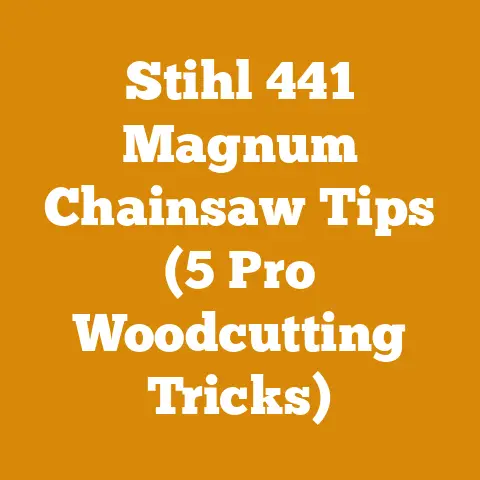Stihl 066 Specs Compared (5 Key Features Every Logger Needs)
Budgeting for a Beast: Stihl 066 Specs Compared & Costs Every Logger Needs to Know
When considering a chainsaw like the Stihl 066, you’re not just thinking about power; you’re thinking about investment. Whether you’re a seasoned logger or a serious firewood enthusiast, understanding the costs associated with a saw of this caliber is crucial. Before we dive into the specs and features, let’s talk budget.
Budget Options:
- The “I’m All In” Budget: This is for the professional who needs the Stihl 066 for daily work and demands top performance. You’re likely looking at a new or expertly refurbished model, and you’re prepared to invest in quality maintenance and accessories.
- The “Strategic Saver” Budget: This is for the experienced user who understands the value of a well-maintained used saw and is willing to put in some elbow grease. You’ll be searching for a used Stihl 066 in good condition, ready to invest in necessary repairs and upgrades.
- The “Weekend Warrior” Budget: This is for the homeowner or occasional user who needs a powerful saw for specific projects but doesn’t require it for daily use. A well-maintained used Stihl 066 might be a viable option, but you’ll need to carefully consider the potential for higher maintenance costs.
No matter your budget, understanding the Stihl 066’s specs and the associated costs is key to making an informed decision. So, let’s dive in!
Stihl 066: 5 Key Features for Loggers & Their Cost Implications
The Stihl 066, also known as the Magnum, is a legend for a reason. Its power and durability have made it a favorite among loggers and serious woodcutters for decades. But what makes it so special, and how do these features impact your budget?
1. Raw Power & Engine Displacement:
- The Spec: The Stihl 066 boasts a powerful 91.6 cc (5.6 cu. in.) two-stroke engine. This displacement puts it squarely in the professional-grade category.
- Why It Matters: That engine size translates to serious cutting power, allowing you to fell large trees and buck thick logs with relative ease. This is crucial for loggers who need to maximize their output.
- Cost Implications:
- Fuel Consumption: Larger engines consume more fuel. Expect to use significantly more fuel with a Stihl 066 compared to smaller saws. This directly impacts your operating costs. I remember one particularly long day clearing a property line; I went through nearly two gallons of fuel with my 066. That’s a lot of money when fuel prices are high!
- Maintenance: Larger engines often require more frequent maintenance. Spark plugs, air filters, and fuel filters will need to be replaced more often, adding to your long-term costs.
- Initial Investment: New or expertly refurbished Stihl 066 models command a premium price due to their power and reputation. Finding a good used one can save money, but repairs might be needed.
Data Point: A 91.6cc engine typically consumes around 0.6-0.8 liters of fuel per hour under heavy load.
2. Bar Length Versatility:
- The Spec: The Stihl 066 can handle a wide range of bar lengths, typically from 20 inches up to 36 inches or even longer.
- Why It Matters: This versatility allows you to adapt the saw to different cutting tasks. A shorter bar is ideal for limbing and smaller trees, while a longer bar is essential for felling large diameter trees.
- Cost Implications:
- Bar & Chain Costs: Different bar lengths require different chains, adding to your initial investment and ongoing expenses. High-quality chains are essential for safety and performance, and they aren’t cheap.
- Matching Bar to Task: Using the wrong bar length can lead to inefficient cutting and increased wear and tear on the saw. This can translate to higher maintenance costs and a shorter lifespan.
- Safety: Longer bars require more skill and caution to operate safely. Accidents can lead to costly repairs and, more importantly, injuries.
Data Point: A 32-inch bar and chain combination for a Stihl 066 typically costs between $150 and $250, depending on the brand and quality.
3. Durable Construction & Reliability:
- The Spec: The Stihl 066 is known for its robust construction and reliability. It’s built to withstand the rigors of professional use.
- Why It Matters: Durability means less downtime and fewer repairs, which is critical for loggers who rely on their saws for their livelihood.
- Cost Implications:
- Longevity: A well-maintained Stihl 066 can last for decades, providing a solid return on investment. I’ve seen 066’s still running strong after 20+ years of heavy use.
- Resale Value: Even used Stihl 066 models hold their value well due to their reputation for durability. This means you can recoup some of your initial investment if you decide to upgrade later.
- Preventative Maintenance: While the 066 is durable, it still requires regular maintenance to ensure optimal performance and longevity. Neglecting maintenance can lead to costly repairs down the road.
Data Point: The average lifespan of a Stihl 066 used in professional logging is 10-15 years with proper maintenance.
4. Anti-Vibration System:
- The Spec: The Stihl 066 features an advanced anti-vibration system that reduces fatigue and improves operator comfort.
- Why It Matters: Reduced vibration allows you to work longer hours without experiencing excessive fatigue or hand-arm vibration syndrome (HAVS). This is crucial for maintaining productivity and preventing long-term health problems.
- Cost Implications:
- Increased Productivity: Reduced fatigue translates to increased productivity, allowing you to cut more wood in a day.
- Reduced Healthcare Costs: Preventing HAVS can save you money on medical expenses in the long run. HAVS can lead to serious nerve and circulatory damage.
- Maintenance: The anti-vibration system itself requires occasional maintenance. Rubber mounts and springs can wear out over time and need to be replaced.
Data Point: HAVS can cost employers thousands of dollars per employee in medical expenses and lost productivity.
5. Availability of Parts & Service:
- The Spec: The Stihl 066 is a popular and well-established model, which means that parts and service are readily available in most areas.
- Why It Matters: Easy access to parts and service means less downtime when repairs are needed. This is crucial for minimizing disruptions to your workflow.
- Cost Implications:
- Faster Repairs: Readily available parts mean faster repairs, getting you back to work sooner.
- Lower Repair Costs: Competition among parts suppliers can help keep repair costs down.
- DIY Repairs: The Stihl 066 is relatively easy to work on, allowing you to perform some repairs yourself and save on labor costs. I’ve rebuilt carburetors and replaced fuel lines on my 066 many times, saving myself a lot of money in the process.
Data Point: The Stihl 066 is one of the most widely supported chainsaws in terms of aftermarket parts availability.
Breaking Down the Costs: A Detailed Look
Now that we’ve examined the key features of the Stihl 066, let’s break down the specific costs you can expect to encounter:
1. Initial Purchase Price:
- New: A new Stihl 066 (if you can find one – they are no longer in production) would likely cost upwards of $1200-$1500.
- Refurbished: Expertly refurbished models can range from $800-$1200, depending on the condition and the extent of the refurbishment.
- Used: Used Stihl 066 models can be found for as little as $400-$800, but be prepared to invest in repairs and upgrades.
Factors Affecting Price:
- Condition: The overall condition of the saw is the primary factor affecting price. Look for saws with minimal wear and tear, good compression, and no major damage.
- Location: Prices can vary depending on your location. Areas with a high demand for logging equipment may have higher prices.
- Seller: Prices can also vary depending on the seller. Private sellers may offer lower prices than dealers, but they may not offer warranties or guarantees.
2. Fuel & Oil Costs:
- Fuel: As mentioned earlier, the Stihl 066 consumes a significant amount of fuel. Expect to use around 0.6-0.8 liters of fuel per hour under heavy load. At a fuel cost of $4 per gallon (approximately $1 per liter), you’re looking at around $0.60-$0.80 per hour in fuel costs.
- Oil: Two-stroke engines require a mix of fuel and oil. Use a high-quality two-stroke oil at the recommended ratio (typically 50:1) to ensure proper lubrication and engine protection. A gallon of two-stroke oil typically costs around $20-$30.
Calculating Fuel & Oil Costs:
- Fuel Cost per Hour: (Fuel Consumption in Liters/Hour) x (Fuel Cost per Liter)
- Oil Cost per Hour: (Fuel Consumption in Liters/Hour) / (Oil Ratio) x (Oil Cost per Liter)
Example:
- Fuel Consumption: 0.7 liters/hour
- Fuel Cost: $1/liter
- Oil Ratio: 50:1
- Oil Cost: $5/liter (calculated from $25 per 5-liter jug)
Fuel Cost per Hour: 0.7 liters/hour x $1/liter = $0.70/hour Oil Cost per Hour: 0.7 liters/hour / 50 x $5/liter = $0.07/hour Total Fuel & Oil Cost per Hour: $0.70 + $0.07 = $0.77/hour
3. Bar & Chain Costs:
- Bar: A high-quality bar for a Stihl 066 typically costs between $80 and $150, depending on the length and brand.
- Chain: Chains need to be replaced regularly, depending on the type of wood you’re cutting and how often you sharpen them. A single chain can cost between $30 and $70.
Factors Affecting Bar & Chain Costs:
- Bar Length: Longer bars are more expensive than shorter bars.
- Chain Type: Different chain types are designed for different cutting tasks. Hardwood chains are more expensive than softwood chains.
- Brand: High-quality brands like Stihl, Oregon, and Husqvarna tend to be more expensive than generic brands.
4. Maintenance & Repair Costs:
- Regular Maintenance: Regular maintenance tasks include cleaning the air filter, replacing the spark plug, sharpening the chain, and lubricating the bar. These tasks can be performed yourself and typically cost around $10-$20 per month.
- Repairs: Major repairs can be costly. A carburetor rebuild can cost $50-$100, while an engine rebuild can cost $300-$500 or more.
Preventative Maintenance Tips:
- Clean the air filter regularly. A dirty air filter can restrict airflow and cause the engine to overheat.
- Sharpen the chain frequently. A dull chain can make cutting more difficult and increase the risk of kickback.
- Lubricate the bar regularly. A well-lubricated bar will reduce friction and wear and tear on the chain.
- Use high-quality fuel and oil. Using low-quality fuel and oil can damage the engine.
- Store the saw properly. Store the saw in a dry place to prevent rust and corrosion.
5. Safety Gear Costs:
- Helmet: A good quality helmet with a face shield and ear protection is essential for safety. Expect to pay around $50-$100 for a helmet.
- Chaps: Chainsaw chaps are designed to protect your legs from cuts. They are made of multiple layers of ballistic nylon that will jam the chain if it comes into contact with them. Expect to pay around $80-$150 for a pair of chaps.
- Gloves: Gloves provide a better grip and protect your hands from cuts and abrasions. Expect to pay around $20-$40 for a pair of gloves.
- Boots: Steel-toed boots with good ankle support are essential for protecting your feet and ankles. Expect to pay around $100-$200 for a pair of boots.
6. Permits & Licenses (if applicable):
- In some areas, you may need permits or licenses to cut trees. The cost of these permits can vary depending on your location and the type of trees you’re cutting. Check with your local authorities to determine what permits are required.
Case Study: Budgeting for a Firewood Business with a Stihl 066
Let’s consider a case study of someone starting a small firewood business using a Stihl 066. This will illustrate how to apply these cost considerations in a real-world scenario.
Scenario: John wants to start a firewood business, selling seasoned hardwood (oak, maple, and hickory) to local residents. He plans to use a Stihl 066 for felling, bucking, and splitting. He aims to produce 50 cords of firewood per year.
Cost Breakdown:
- Equipment:
- Used Stihl 066: $600 (initial investment, assuming some repairs are needed)
- Bar & Chain (25″ bar): $200
- Splitting Maul: $80
- Wedges & Sledgehammer: $50
- Safety Gear (Helmet, Chaps, Gloves, Boots): $350
- Total Equipment Cost: $1280
- Operating Costs (Annual):
- Fuel & Oil: Assuming 2 hours of saw use per cord, at $0.77/hour, total fuel & oil cost = 50 cords * 2 hours/cord * $0.77/hour = $77
- Chain Sharpening/Replacement: $200 (estimate for sharpening and replacing chains)
- Saw Maintenance (Air filter, spark plugs, etc.): $100
- Advertising & Marketing: $200
- Transportation (Truck & Trailer): $500 (estimate for fuel and maintenance)
- Total Annual Operating Costs: $1077
- Raw Materials (Wood):
- John can acquire standing dead trees for free with permission from local landowners.
- Permit Fees: $0 (assuming no permits required for dead tree removal)
- Total Raw Material Cost: $0
Financial Analysis:
- Total Initial Investment: $1280 (Equipment)
- Total Annual Costs: $1077 (Operating Costs)
- Cost per Cord: $1077 / 50 cords = $21.54 per cord (excluding initial equipment cost)
Pricing Strategy:
- John needs to consider the local market price for firewood to determine his selling price.
- Industry Benchmark: The average price per cord of seasoned hardwood firewood ranges from $200 to $400, depending on location and wood type.
- Profit Margin: If John sells each cord for $250, his profit margin would be $250 – $21.54 = $228.46 per cord.
- Annual Profit: 50 cords * $228.46/cord = $11,423
- Payback Period: The initial equipment cost of $1280 would be recovered in approximately 0.11 years or about 1.36 months ($1280/$11423).
Important Considerations:
- Labor Costs: This analysis assumes John is doing all the work himself. If he hires help, labor costs will significantly impact his profitability.
- Unexpected Repairs: John should factor in a contingency fund for unexpected repairs to the Stihl 066 or other equipment.
- Market Fluctuations: Firewood prices can fluctuate depending on weather conditions and local demand.
- Seasonality: Firewood sales are typically highest during the fall and winter months.
Cost Optimization Strategies
Here are some practical tips for optimizing your costs when using a Stihl 066 or similar chainsaw:
- Sharpen Your Chains Regularly: A sharp chain cuts more efficiently, reducing fuel consumption and wear and tear on the saw. Learn to sharpen your chains yourself to save money on professional sharpening services.
- Use the Right Chain for the Job: Using the wrong chain can lead to inefficient cutting and increased wear and tear. Select the appropriate chain type for the type of wood you’re cutting.
- Maintain Your Saw Properly: Regular maintenance can prevent costly repairs. Follow the manufacturer’s recommendations for maintenance schedules and procedures.
- Buy Fuel and Oil in Bulk: Buying fuel and oil in bulk can save you money in the long run.
- Shop Around for Parts: Compare prices from different suppliers to find the best deals on parts and accessories.
- Consider Buying Used Equipment: Used equipment can be a cost-effective alternative to buying new. However, be sure to inspect used equipment carefully before purchasing it.
- Negotiate Prices: Don’t be afraid to negotiate prices with suppliers and vendors.
- Take Advantage of Discounts: Look for discounts and promotions on equipment, parts, and supplies.
- Learn to Repair Your Own Saw: Learning to repair your own saw can save you money on labor costs. There are many online resources available to help you learn basic chainsaw repair.
- Optimize Cutting Techniques: Proper cutting techniques can reduce fuel consumption and wear and tear on the saw. Learn how to fell trees and buck logs efficiently.
- Plan Your Work: Careful planning can help you minimize wasted time and resources. Plan your cutting projects in advance to ensure you have the right equipment and supplies.
- Use the Right Bar Length: Avoid using excessively long bars as they require more power and can increase the risk of kickback. Choose a bar length that is appropriate for the size of the trees you’re cutting.
- Avoid Over-Revving the Engine: Over-revving the engine can damage it and shorten its lifespan. Operate the saw at the recommended RPM range.
- Store Fuel Properly: Store fuel in a cool, dry place to prevent it from deteriorating. Use a fuel stabilizer to extend the shelf life of fuel.
- Keep the Saw Clean: A clean saw runs more efficiently and is less likely to experience problems. Clean the saw regularly to remove sawdust and debris.
Understanding Timber Prices & Firewood Market Rates
To effectively budget for wood processing or firewood preparation projects, it’s essential to understand timber prices and firewood market rates. These prices can vary significantly depending on several factors:
- Species: Hardwoods like oak, maple, and hickory typically command higher prices than softwoods like pine and fir.
- Quality: High-quality timber with minimal defects will fetch a higher price.
- Location: Timber prices can vary depending on the region and the accessibility of the timber.
- Demand: Firewood market rates are influenced by local demand, weather conditions, and the availability of alternative heating sources.
Data Sources:
- USDA Forest Service: The USDA Forest Service provides data on timber prices and market trends.
- State Forestry Agencies: State forestry agencies often publish data on timber prices and firewood market rates within their respective states.
- Industry Associations: Industry associations like the National Hardwood Lumber Association (NHLA) and the Wood Component Manufacturers Association (WCMA) provide data and resources related to timber prices and market trends.
- Local Firewood Suppliers: Contacting local firewood suppliers can provide insights into current market rates in your area.
Example Timber Prices (Approximate):
- Oak: $500-$800 per thousand board feet (MBF)
- Maple: $400-$700 per MBF
- Pine: $200-$400 per MBF
Example Firewood Market Rates (Approximate):
- Seasoned Hardwood: $200-$400 per cord
- Seasoned Softwood: $150-$300 per cord
Remember: These are just approximate prices. It’s essential to research local market conditions to determine accurate prices for your specific area.
Calculating Wood Volume: Board Feet & Cords
Understanding how to calculate wood volume is crucial for budgeting and cost management in wood processing projects. The two most common units of measurement are board feet and cords.
Board Feet:
- A board foot is a unit of measurement equal to 144 cubic inches. It’s typically used for measuring lumber and timber.
- Formula for Calculating Board Feet: (Thickness in inches) x (Width in inches) x (Length in inches) / 144
Example:
- A board that is 2 inches thick, 12 inches wide, and 8 feet (96 inches) long contains: (2 x 12 x 96) / 144 = 16 board feet.
Cords:
- A cord is a unit of measurement equal to 128 cubic feet. It’s typically used for measuring firewood.
- A standard cord is a stack of wood that is 4 feet high, 4 feet wide, and 8 feet long.
- Estimating Cords from Log Diameter and Length: This is more complex and often involves using tables or online calculators. However, a rough estimate can be made by calculating the volume of the log in cubic feet and dividing by 128.
Example:
- A log with a diameter of 16 inches and a length of 10 feet has a volume of approximately 13.96 cubic feet.
- To estimate the number of cords in the log, divide the volume by 128: 13.96 / 128 = 0.11 cords (approximately).
Important Note: These are just estimates. The actual volume of wood in a cord can vary depending on how tightly the wood is stacked and the size and shape of the individual pieces.
Drying Time Estimation: Moisture Content & Wood Species
The drying time for wood is a critical factor in firewood preparation. Seasoned firewood burns more efficiently and produces less smoke than green firewood.
Factors Affecting Drying Time:
- Wood Species: Hardwoods like oak and maple take longer to dry than softwoods like pine and fir.
- Moisture Content: Green wood can have a moisture content of 50% or higher. Seasoned firewood should have a moisture content of 20% or lower.
- Climate: Warm, dry climates are ideal for drying firewood. Humid climates can significantly increase drying time.
- Stacking Method: Stacking firewood in a way that allows for good air circulation will speed up the drying process.
Estimating Drying Time:
- General Rule of Thumb: Hardwoods typically take 6-12 months to dry, while softwoods typically take 3-6 months to dry.
- Moisture Meter: Using a moisture meter is the most accurate way to determine the moisture content of firewood.
- Visual Inspection: Seasoned firewood will be lighter in weight and have cracks in the end grain.
Tips for Speeding Up Drying Time:
- Split the Wood: Splitting the wood into smaller pieces will increase the surface area exposed to air and speed up the drying process.
- Stack the Wood Properly: Stack the wood in a single row with good air circulation. Leave space between the rows.
- Elevate the Wood: Elevate the wood off the ground to prevent moisture from wicking up into the wood.
- Cover the Wood: Cover the wood with a tarp to protect it from rain and snow. However, be sure to leave the sides open to allow for air circulation.
Actionable Takeaways & Next Steps
Investing in a Stihl 066 is a serious decision. It’s a powerful tool that can significantly increase your productivity, but it also comes with a significant cost. By carefully considering the factors outlined in this article, you can make an informed decision and budget effectively for your wood processing or firewood preparation projects.
Here are some actionable takeaways:
- Assess Your Needs: Determine your specific needs and budget before purchasing a Stihl 066.
- Research Prices: Compare prices from different sources to find the best deal.
- Inspect Used Equipment Carefully: If you’re considering buying a used Stihl 066, inspect it carefully for signs of wear and tear.
- Factor in Operating Costs: Don’t forget to factor in fuel, oil, bar, chain, and maintenance costs when budgeting for your project.
- Implement Cost Optimization Strategies: Use the cost optimization strategies outlined in this article to minimize your expenses.
- Understand Timber Prices & Firewood Market Rates: Research local market conditions to determine accurate prices for timber and firewood.
- Calculate Wood Volume Accurately: Learn how to calculate wood volume in board feet and cords.
- Estimate Drying Time: Understand the factors that affect drying time and estimate how long it will take to season your firewood.
Next Steps:
- Define Your Project: Clearly define your wood processing or firewood preparation project. What are your goals? What resources do you need?
- Create a Detailed Budget: Create a detailed budget that includes all of the costs outlined in this article.
- Research Equipment Options: Research different chainsaw models and compare their features and prices.
- Contact Local Suppliers: Contact local suppliers to get quotes on timber, firewood, and other materials.
- Develop a Marketing Plan: If you’re starting a firewood business, develop a marketing plan to attract customers.
- Start Small: If you’re new to wood processing or firewood preparation, start with a small project and gradually increase the scale as you gain experience.
Remember, success in wood processing or firewood preparation requires careful planning, attention to detail, and a willingness to learn. By following the tips and guidelines outlined in this article, you can increase your chances of success and make your projects more profitable. And, with a well-maintained Stihl 066 by your side, you’ll be well-equipped to tackle even the toughest jobs. Now, get out there and make some sawdust!






